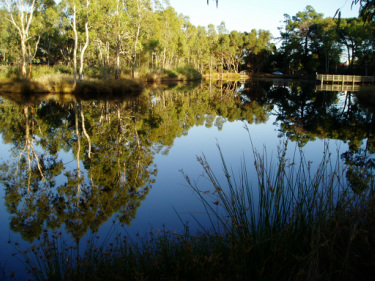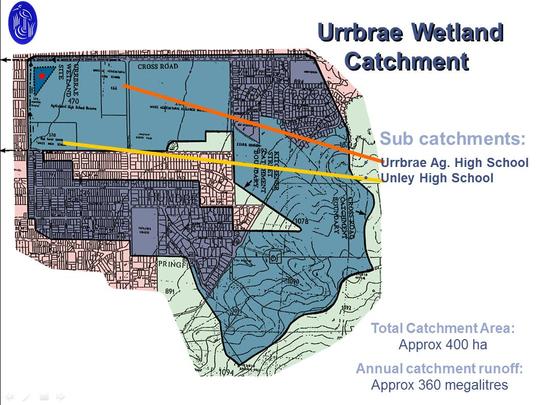Why a Wetland?

Although it is man-made wetland, the Urrbrae Wetland has been designed to function as a water retention basin whilst having the benefits of natural wetland characteristics.
The useful function of the Urrbrae Wetland includes:
The cleansing of the stormwater by:
- Filtering out large debris through the trash racks
- The water flow is slowed down causing sand and sediments to fall to the bottom, this is called sedimentation.
- Heavy metals, salts and bacteria are removed as they "stick' onto the falling particles
- Reeds, sedges and other native plants that make up the riparian zone, filter out much of the of salts and heavy metals.
Flood Prevention
The wetlands is able to store up to 17.7 milion litres of water (thats over 7 olympic swimming pools). Every year, between 300-400 million litres of stormwater will flow through the wetland.
Provides an aquatic habitat
The wetlands have been planted with local plants, providing a home for numerous species of birds, reptiles, amphibians and macro invertebrates.
Provides the community with unique educational programs
The Urrbrae Wetlands offers authentic and engaging learning oppertunities for every age group in any learning area.
Recycling Water
Harvested stormwater is used to irrigate the vine yards at Urrbrae Agricultural High School, taking pressure of the Murray River system.
The Big Picture
While the Urrbrae Wetland only cover an area of approximately 6 hectares its catchment area is around 380 hectares (see figure below). That means that any drop of water, which falls in this area could potentially end up in the wetland, along with many different pollutants that the water picks up along way. Before the wetlands were developed this water and its polluants would have continued to flow through the storm water pipes, flowing into Brown Hill Creek and the Patawalonga then taken the polluants out to sea. BUT the wetland stops many of the pollutants from continuing their journey.
The Urrbrae Wetland has many positive impacts at a local, regional and national level
LOCAL BENEFITS
- Reduces the frequency of local flooding.
- Removes rubbish, organic matter, pathogens chemicals and other pollutants from the water.
- Captures and filters the storm water so that it can be use for irrigation purposes on Urrbrae Farm.
- Provides a protected habitat for native flora and fauna, thus increasing the biodiversity of the area.
- Provides a valuable education resource.
REGIONAL BENEFITS
- Cleans incomming storm water, thereby improving the quality of water that is entering Brown Hill Creek, the Patawalonga basin and the Gulf of St Vincent.
- Provides an education site to students from the region, so they can develop ways to improve water sustainability in their own localities.
NATIONAL BENEFITS
- Cleans storm water, allowing it to the reused for irrigation, thereby taking the pressure of the ailing Murray River.
Incoporate the Urban Wetland concept into your curriculum
There are many themes centered around the concepts of Urban Wetlands. These include:
- Stormwater Management
- Aquifer Storage
- The Water Cycle
- Cleaning Dirty Water (water chemistry)
- Water Sustainability
- Catchments (from hills to oceans)
- Construction of Artificial Wetlands
- Environmental, Economical and Social impacts of Urban Wetlands at a Local, Regional and National level.
There are many, practicals activities that students can be involved in when the visit the wetland. For example:
Does the wetland actually clean the water?
This activity involves the student taking water samples from three different locations around the wetland.
- Kitchner St Inlet
- Cross Rd Inlet
- The Outlet
The students then carryout a range of test on each sample including testing the nitrate, phosphate and dissolved oxygen levels, measure turbidity, salt and pH. They investigate what a heathly range is for each test, analyse their results and answer the proposed question - Does the Wetland Actually Clean the Water?
This activity can be adapted to suit a range of year levels
- Stormwater Management
- Aquifer Storage
- The Water Cycle
- Cleaning Dirty Water (water chemistry)
- Water Sustainability
- Catchments (from hills to oceans)
- Construction of Artificial Wetlands
- Environmental, Economical and Social impacts of Urban Wetlands at a Local, Regional and National level.
There are many, practicals activities that students can be involved in when the visit the wetland. For example:
Does the wetland actually clean the water?
This activity involves the student taking water samples from three different locations around the wetland.
- Kitchner St Inlet
- Cross Rd Inlet
- The Outlet
The students then carryout a range of test on each sample including testing the nitrate, phosphate and dissolved oxygen levels, measure turbidity, salt and pH. They investigate what a heathly range is for each test, analyse their results and answer the proposed question - Does the Wetland Actually Clean the Water?
This activity can be adapted to suit a range of year levels
| water_quality_testing.pdf | |
| File Size: | 202 kb |
| File Type: | |
Back in the Classroom
The students experiences at the Wetland can then be extended back to the classroom, where they can use their understanding of wetland function to:
- Design an artificial wetland which considers - The lining, clay or plastic? why?
- Its size and maximum depth
- Create a variety of habitats
- Its shape (any islands?)
- Maintaining the banks of the pond
- Use water cleaning plants (plants need to siut original environment for soil types)
- Control maximum height and allow for overflow conditions (ephemeral zones)
- Consider insect and bird control
- On going maintenance, etc
- What would happen if fertilizers and phosphates were to leak into the Urrbrae Wetland?
- Where could other urban wetlands be constructed? (look at the region before 1836)
- Should roads become permeable?
- Design an artificial wetland which considers - The lining, clay or plastic? why?
- Its size and maximum depth
- Create a variety of habitats
- Its shape (any islands?)
- Maintaining the banks of the pond
- Use water cleaning plants (plants need to siut original environment for soil types)
- Control maximum height and allow for overflow conditions (ephemeral zones)
- Consider insect and bird control
- On going maintenance, etc
- What would happen if fertilizers and phosphates were to leak into the Urrbrae Wetland?
- Where could other urban wetlands be constructed? (look at the region before 1836)
- Should roads become permeable?
To find our more on how The Urrbrae Wetland Facility can assist you in achieving outcomes based around urban wetland importance and function, simply contact the Wetland Manager.

